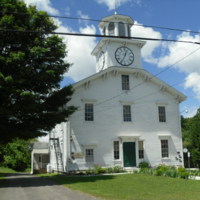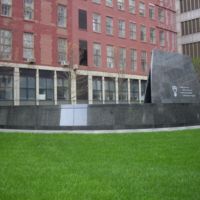
National Abolition Hall of Fame and Museum
The National Abolition Hall of Fame and Museum occupies the upper floor of the former Presbyterian Church of Smithfield, built in 1820. In 1835 it was the site of the first complete meeting of the New York State Anti-Slavery Society, and it opened as a museum to represent the history of the abolition movement in 2004. The lower floor houses the Smithfield Community Centre. In 1994, the building was added to the New York State and National Registers of Historic Places. In 2004, it was designated as a site on the New York State Underground Railroad Heritage Trail.
The Hall of Fame and Museum honours abolitionists and their achievements, periodically inducting new members. It also aims to educate about the legacy of the movement and to inspire its visitors to engage in the 'new struggle' to end racism. The museum features an introductory film that provides background context to the abolition movement, regarding the transatlantic slave trade. Written text panels, archival materials and art are used to add further depth to the narrative of the American abolition movement.
The museum also runs a programme of visitor events, and education activities.

African Burial Ground National Monument
The memorial was founded after human remains were discovered underground by city workmen who were attempting to build some government offices in the 1990s. The remains belonged to enslaved Africans who were building New Amsterdam (present day New York). The African Burial Ground National Monument honours these Africans’ memory, having reburied them in a more respectful manner. It is the oldest and largest known excavated burial ground in North America for both free and enslaved Africans. A 'sacred space in Manhattan', the mission of the memorial is to acknowledge New York's involvement with slavery and the slave trade to provide a respectful and symbolic space for the reinternment of the African remains found at the site.
The facilities at the centre include a range of exhibits, a twenty-minute film and a book/gift shop. In addition, the memorial also offers on-site presentations in the visitor centre consisting of an hour long programme. The memorial is managed by the National Park Service and the U.S Department of the Interior.
The process of memorialization and the research conducted about the enslaved African skeletal remains was negotiated extensively between the General Services Administration, the African American descendant community, historians, archaeologists, and anthropologists. Civic engagement led to the ancestral remains reinternment within the original site of discovery. An external memorial, an interpretive centre, and research library were constructed to further commemorate the financial and physical contributions of enslaved Africans to colonial New York, and to honour their memory. The exhibits examine the history of the initial discovery, the research conducted to identify the remains, the documentation process and associated artefacts.
![Anonymous, West 116th Street at 8th Ave, Harlem, NYC, 2007 [destroyed].jpg Anonymous, West 116th Street at 8th Ave, Harlem, NYC, 2007 [destroyed].jpg](https://486312.frmmmguz.asia/files/square_thumbnails/68ba2c99969cfee543cc2473ef6ae0da.jpg)
If There is No Struggle
This mural was painted by an anonymous artist around 2007 and no longer exists, but is an important example of both the ephemeral and guerrilla nature of murals: some last for short periods of time on buildings and streets in communities. This particular mural was created in West Harlem and focused on the abolitionist Frederick Douglass. Borrowing his famous phrase from 1857, “If there is no struggle, there is no progress,” the muralist also adds a drumming figure to the centre of the mural.